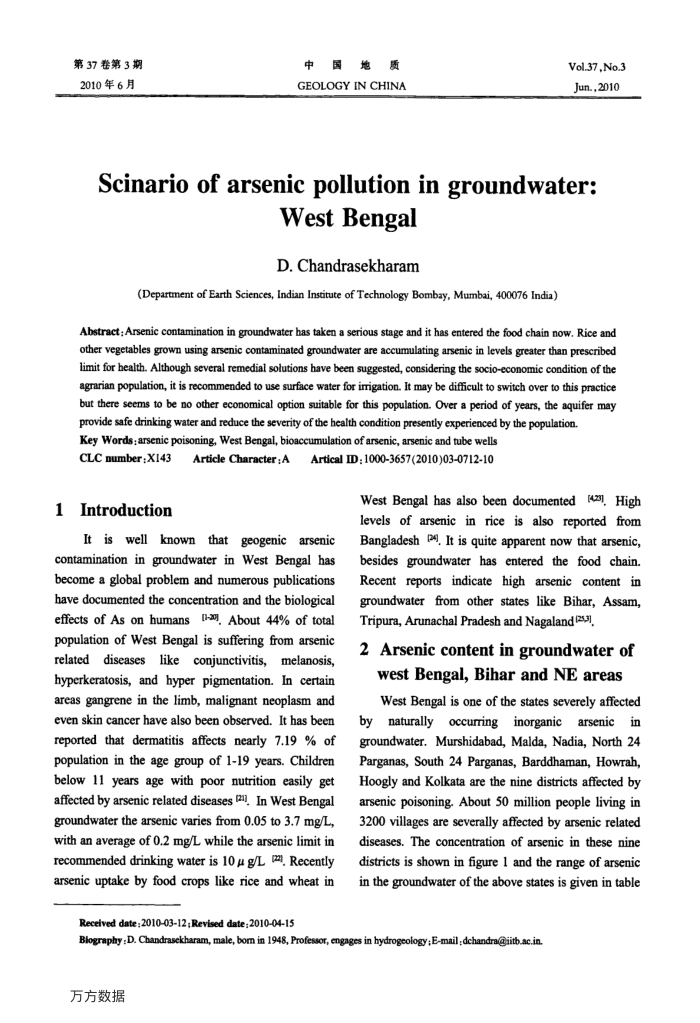您当前的位置:首页>论文资料>西孟加拉地区地下水砷污染
内容简介
 第37卷第3期 2010年6月
第37卷第3期 2010年6月中
国
地
质
GEOLOGY IN CHINA
Vol.37,No.3 Jun.,2010
Scinario of arsenicpollutioningroundwater:
West Bengal D.Chandrasekharam
(Department of Earth Sciences, Indian Institute of Technology Bombay, Mumbai, 400076 India)
Abstract: Arsenic contamination in groundwater has taken a serious stage and it has entered the food chain now. Rice and other vegetables grown using arsenic contaminated groundwater are accumulating arsenic in levels greater than prescribed limit for health. Although several remedial solutions have been suggested, considering the socio-economic condition of the agrarian population, it is recommended to use surface water for irrigation. It may be difficult to switch over to this practice but there seems to be no other economical option suitable for this population. Over a period of years, the aquifer may
provide safe drinking water and reduce the severity of the health condition presently experienced by the population. Key Words:arsenic poisoning, West Bengal, bioaccumulation of arsenic, arsenic and tube wells
CLC number;X143 1Introduction
Article Character;A
Artical ID:1000-3657(2010)03-0712-10
West Bengal has also been documented [2], High levels of arsenic in rice is also reported from
Itiswellknownthatgeogenicarsenic contamination in groundwater in West Bengal has become a global problem and numerous publications have documented the concentration and the biological effects of Asonhumans[-.About44%of total population of West Bengal is suffering from arsenic relateddiseaseslikeconjunctivitis,melanosis, hyperkeratosis, and hyper pigmentation. In certain areas gangrene in the limb, malignant neoplasm and even skin cancerhavealsobeen observed.It hasbeen reported that dermatitis affects nearly 7.19 %of population in the age group of 1-19 years. Children below 11 years age with poor nutrition easily get affected by arsenic related diseases (2], In West Bengal groundwater the arsenic varies from 0.05 to 3.7 mg/L, with an average of 0.2 mg/L while the arsenic limit in recommended drinking water is 10 μ g/L (2, Recently arsenic uptake by food crops like rice and wheat in
Received date:2010-03-12;Revised date;2010-04-15
Bangladesh P, It is quite apparent now that arsenic, besides groundwater has entered the food chain Recent reportsindicatehigharseniccontentin groundwater from other states like Bihar, Assam, Tripura, Arunachal Pradesh and Nagaland (2)
2 Arsenic content in groundwater of westBengal,Bihar andNEareas West Bengal is one of the states severely affected
bynaturally
occurringinorganic
arsenic
in
groundwater. Murshidabad, Malda, Nadia, North 24 Parganas, South 24 Parganas, Barddhaman, Howrah, Hoogly and Kolkata are the nine districts affected by arsenic poisoning. About 50 million people living in 3200 villages are severally affected by arsenic related diseases. The concentration of arsenic in these nine districts is shown in figure 1 and the range of arsenic in the groundwater of the above states is given in table
Biography:D. Chandrasckharam, male, bom in 1948,Professor, engages in hydrogeology;Email;dchandra@itb.ac.in 万方数据
上一章:塔里木盆地深反射地震资料处理
下一章:四川阿坝土壤与空气中氡气浓度及分布调查